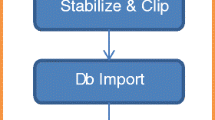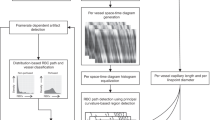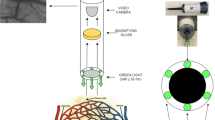Abstract
A technique is described for rapid and reproducible analysis of split-drop micropuncture sequences recorded on film. Automatic identification of the droplet menisci in each cine frame, and subsequent evaluation is performed by a computerised T.V. image analysis system. In comparison with a more conventional technique, the improvement in reproducibility of the analysis is achieved without loss of accuracy and is accompanied by a three fold increase in speed.
Similar content being viewed by others
References
Bishop, J. H. V., Green, R., Thomas, S.: Effects of glucose on water and sodium reabsorption in the proximal convoluted tubule of rat kidney. J. Physiol. (Lond.)275, 481–493 (1978)
Gertz, K. H.: Transtubuläre Natriumchloridflüsse und Permeabilität für Nichtelektrolyte im proximalen und distalen Konvolut der Rattenniere. Pflügers Arch. ges. Physiol.276, 336–356 (1963)
Grandchamp, A., Boulpaep, E. L.: Effect of intraluminal pressure on proximal tubular sodium reabsorption. A shrinking drop micropuncture study. Yale J. Biol. Med.45, 275–288 (1972)
Green, R., Bishop, J. H. V., Giebisch, G.: Ionic requirements of proximal tubular sodium transport. III Selective luminal ion substitution. Am. J. Physiol.236, F268-F277 (1979)
Györy, A. Z.: Reexamination of the split oil droplet method as applied to kidney tubules. Pflügers Arch.324, 328–343 (1971)
Györy, A. Z.: Sources of error in and limitations in the use oft 1/2 as a measure of tubular reabsorptive capacity. Yale J. Biol. Med.45, 269–274 (1972)
Nakajima, K., Clapp, J. R., Robinson, R. R.: Limitations of the shrinking-drop micropuncture technique. Am. J. Physiol.219, 345–357 (1970)
Neumann, K. H., Rector, F. C., Jr.: Mechanism of NaCl and water reabsorption in the proximal convoluted tubule of rat kidney. J. Clin. Invest.58, 1110–1118 (1976)
Sato, K.: Reevaluation of micropuncture techniques: some of the factors which affect the rate of fluid absorption by the proximal tubule. In: Biochemical aspects of renal function: Current problems in clinical biochemistry, Vol. 4 (S. Angielski and U. C. Dubach, eds.), pp. 175–187. Bern-Stuttgart-Wien: Huber 1975
Steinhausen, M.: Messungen des tubulären Harnstromes und der tubulären Reabsorption unter erhöhtem Ureterdruck. Intravitalmikroskopische Untersuchungen an der Nierenrinde von Ratten. Pflügers Arch. ges. Physiol.298, 105–130 (1967)
Weinman, E. J., Hardy, R. J., Kashgarian, M., Hayslett, J. P.: Examination of the Gertz techniques as applied to the proximal tubule of the rat kidney. Yale J. Biol. Med.45, 289–298 (1972)
Author information
Authors and Affiliations
Rights and permissions
About this article
Cite this article
Garland, H.O., Brunt, J.N.H., Taylor, C.J. et al. Computerised image analysis of split-drop micropuncture data. Pflugers Arch. 381, 11–14 (1979). https://doi.org/10.1007/BF00582325
Received:
Issue Date:
DOI: https://doi.org/10.1007/BF00582325




